4 训练目标检测模型
4.1 文件结构搭建
当前的文件夹结构应该是这样的:
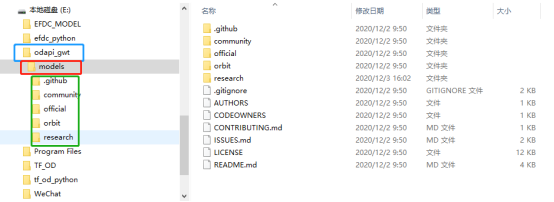
下面需要将文件的树结构变为如下样式:
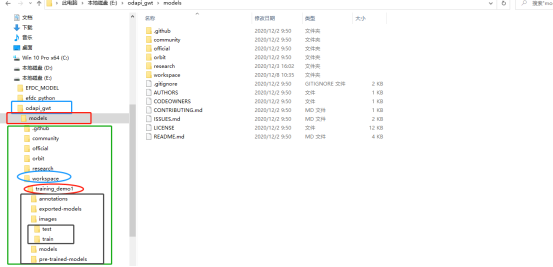
首先在目录下新建一个名为“workspace”的文件夹,该文件夹下面可以新建多个针对不同训练数据集的训练任务,例如training_demo1,training_demo3。
下面给出各个文件夹的说明:
annotations:存储*.csv和*.record格式的数据集的标注文件;
exported-models:存储模型的保存文件;
Images:存储数据集的图片以及标注后的*.xml文件:
- Train:训练数据集的图片以及对应的*.xml文件;
- Test:测试数据集的图片以及对应的*.xml文件;
models:这个文件夹将包含每个训练任务的子文件夹。每个子文件夹将包含训练管道配置文件*.config,以及在训练和评估模型期间生成的所有文件。
- pre-trained-models:这个文件夹将包含下载的预训练模型,这些模型将作为我们训练工作的起始检查点。
实现建立文件结构的python程序
#!/usr/bin/env python
# author:AnFany
# datetime:2020/12/14 16:12
# 建立文件夹框架
MainFolder = r'E:\odapi_gwt\models\workspace\training_demo_RiverFloatage'
FolderDict = {'annotations': 1,
'exported-models': 1,
'images': ['test', 'train'],
'models':1,
'pre-trained-models': 1}
import os
def build_folder(mp=MainFolder, fd=FolderDict):
for dd in fd:
alpath = '%s/%s' % (mp, dd)
if os.path.exists(alpath):
print('文件夹%s已经存在' % dd)
pass
else:
if fd[dd] == 1:
os.mkdir(alpath)
else:
for df in fd[dd]:
path = '%s/%s' % (alpath, df)
os.makedirs(path)
return print('创建完毕')
build_folder()
4.2 准备数据集
4.2.1 数据标注
4.2.1.1 安装LabelImg
pip方式安装(建议),激活虚拟环境,执行命令

激活环境,cd进入图片存放的路径,然后运行labelImg即可。
4.2.1.2 爬取百度图片
根据关键词爬取百度图片,可自定义数量。python程序
#!/usr/bin/env python
# author:AnFany
# datetime:2020/12/8 15:31
# 根据名字利用百度图片爬取照片
import re
import os
import requests #导入requests包
from bs4 import BeautifulSoup
# 保存图片的路径
FigPath = r'E:\odapi_gwt\models\workspace\training_demo_james_kobe\images'
HeadUrl = r'https://image.baidu.com/search/acjson?tn=resultjson_com' \
r'&logid=8408718041848823114&ipn=rj&ct=201326592&is=&' \
r'fp=result&queryWord={}&cl=2&lm=-1&ie=utf-8&oe=utf-8' \
r'&adpicid=&st=-1&z=&ic=0&hd=&latest=©right=&word={}'\
r'&s=&se=&tab=&width=&height=&face=0&istype=2&qc=&nc=1&' \
r'fr=&expermode=&force=&pn={}&rn=30&gsm=1e&1607477042497='
Headers = {'User-Agent': 'Mozilla/5.0 (Windows NT 10.0; Win64; x64; rv:83.0) Gecko/20100101 Firefox/83.0'}
# 百度图片网址对应解码
StrTable = {'_z2C$q': ':', '_z&e3B': '.', 'AzdH3F': '/'}
CharTable = {'w': 'a', 'k': 'b', 'v': 'c', '1': 'd', 'j': 'e', 'u': 'f', '2': 'g', 'i': 'h', 't': 'i',
'3': 'j', 'h': 'k', 's': 'l', '4': 'm', 'g': 'n', '5': 'o', 'r': 'p', 'q': 'q', '6': 'r',
'f': 's', 'p': 't', '7': 'u', 'e': 'v', 'o': 'w', '8': '1', 'd': '2', 'n': '3', '9': '4',
'c': '5', 'm': '6', '0': '7', 'b': '8', 'l': '9', 'a': '0'}
def get_keywords_star(keywords, count, name, hu=HeadUrl, h=Headers, fp=FigPath):
fig_count = 0
thirty_count = 1
# 已经下载列表
all_load = {}
while fig_count < count:
all_url = hu.format(keywords, keywords, thirty_count * 30)
strhtml = requests.get(all_url, headers=h, timeout=100)
# 获取网页源码
soup_txt = BeautifulSoup(strhtml.text, 'lxml').text
# 查找
pattern_pic = r'"objURL":"(.*?)"'
# 获得所有url
pic_list = re.findall(pattern_pic, soup_txt)
# url转码函数
def trans_url(exstr, s=StrTable, c=CharTable):
for ks in s:
if ks in exstr:
exstr = exstr.replace(ks, s[ks])
new_url = ''
for ke in exstr:
if ke in c:
new_url += c[ke]
else:
new_url += ke
return new_url
for kk in pic_list:
real_url = trans_url(kk)
prex = real_url.split('.')[-1]
if prex in ['jpg', 'jpeg', 'png']:
if real_url not in all_load:
all_load[real_url] = 0
# 下载图片
try:
load_fig = requests.get(real_url)
figure_str = load_fig.content
if len(figure_str) > 40000:
# 保存图片
with open(r'%s/%s_%s.%s' % (fp, name, fig_count, prex), 'wb') as fogs:
fogs.write(load_fig.content)
fig_count += 1
print('{}已经下载完成{}张'.format(keywords, fig_count))
if fig_count == count:
break
except:
pass
thirty_count += 1
get_keywords_star('詹姆斯', 70, 'LeBron')
get_keywords_star('科比', 70, 'Kobe')
4.2.1.3 图片标注

运行出现界面,
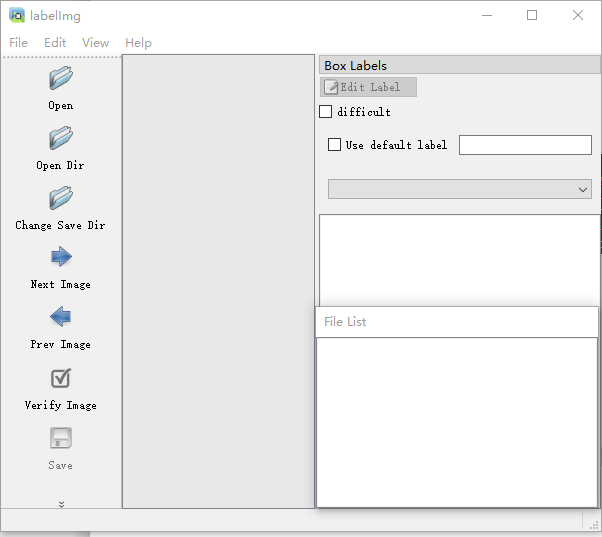
Open Dir 打开存放图片的路径,文件列表显示
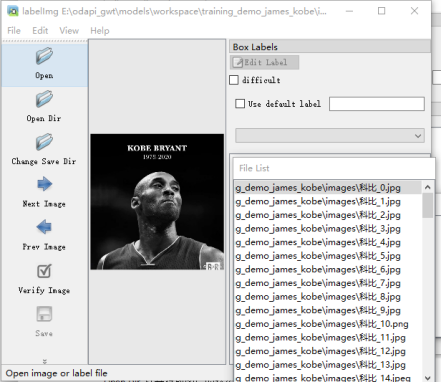
开始进行标注,选择图片右击,选择Create RectBox,鼠标出现十字框,划出类别的对角线,写入标签即可。保存后,每个图片文件都对应一个.xml格式的问文件。
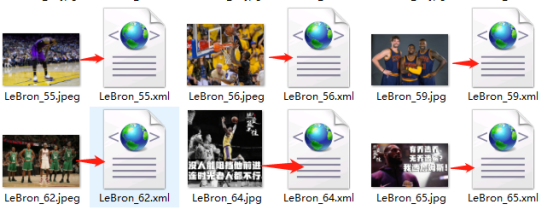
4.2.2 数据集分割
按照一定比例,将图片和对应的.xml文件,分别剪切到train、test文件夹中。
python程序
#!/usr/bin/env python
# author:AnFany
# datetime:2020/12/9 14:52
# 根据比例,将图片以及标注的xml文件进行分割
# 该程序适合图片名称为类别_数字,后缀 为.jpg,jpeg,png的
import os
import numpy as np
import shutil
# 分割数据集,并移动到相应的文件夹
def split_figure_daaset(filepath=r'E:\odapi_gwt\models\workspace\training_demo_james_kobe\images', percent=0.2, anprex='xml'):
class_figure = {}
file_list = os.listdir(filepath)
for f in file_list:
if '.' in f:
name, prex = f.split('.')
c, n = name.split('_')
# 键:类
if c not in class_figure:
class_figure[c] = {}
# xml文件
if prex == anprex:
if anprex not in class_figure[c]:
class_figure[c][anprex] = [f]
else:
class_figure[c][anprex].append(f)
# 图片文件
elif prex in ['jpg', 'jpeg', 'png']:
if '%s.%s' % (name, anprex) in file_list:
if 'fig' not in class_figure[c]:
class_figure[c]['fig'] = [f]
else:
class_figure[c]['fig'].append(f)
# 开始分割
for dc in class_figure:
length = len(class_figure[dc]['fig'])
test_len = int(length * percent)
# 随机选择几个
all_sign = np.arange(length)
test_sign = np.random.choice(all_sign, test_len, replace=False)
test_file = list(np.array(class_figure[dc]['fig'])[test_sign]) + \
list(np.array(class_figure[dc]['xml'])[test_sign])
train_sign = [hj for hj in all_sign if hj not in test_sign]
train_file = list(np.array(class_figure[dc]['fig'])[train_sign]) + \
list(np.array(class_figure[dc]['xml'])[train_sign])
# 开始移动测试文件
for tfile in test_file:
shutil.move('%s/%s' % (filepath, tfile), '%s/test' % filepath)
# 开始移动训练文件
for tfile in train_file:
shutil.move('%s/%s' % (filepath, tfile), '%s/train' % filepath)
return '数据集分割完毕'
print(split_figure_daaset())
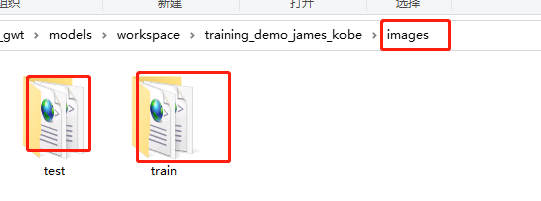
4.2.3 创建标签映射
根据数据集中的类别,创建形如下面格式的映射文件,放在文件夹annotations中。并将该文件的后缀名定义为.pbtxt,名称不限制,示图,注意类别之间不要留有空格。
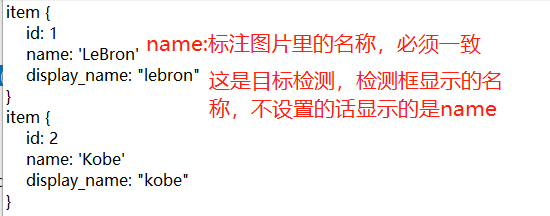
4.2.4 转*.xml为*.record格式
python程序
#!/usr/bin/env python
# author:AnFany
# datetime:2020/12/9 16:16
# 将.xml格式转化为tfrecord格式的数据文件
import os
import glob
import pandas as pd
import io
import xml.etree.ElementTree as ET
os.environ['TF_CPP_MIN_LOG_LEVEL'] = '2' # Suppress TensorFlow logging (1)
import tensorflow.compat.v1 as tf
from PIL import Image
from object_detection.utils import dataset_util, label_map_util
from collections import namedtuple
# .pbtxt文件路劲
PathPbtxt = r'E:\odapi_gwt\models\workspace\training_demo_RiverFloatage\annotations\river_floatage.pbtxt'
def xml_to_df(pxf, ppb=PathPbtxt):
# 根据pbtxt文件,将字符串的类别变为数字类别
label_map = label_map_util.load_labelmap(ppb)
label_map_dict = label_map_util.get_label_map_dict(label_map)
# 遍历.xml文件,将文件中的内容合并成pandas的DataFrame格式
xml_list = []
for subfile in os.listdir(pxf):
name, prex = subfile.split('.')
if prex == 'xml':
# 解析XML文件
tree = ET.parse('%s/%s' % (pxf, subfile))
root = tree.getroot()
for member in root.findall('object'):
value = (root.find('filename').text, #对应的图片
int(root.find('size')[0].text), # 图片的宽度
int(root.find('size')[1].text), # 图片的高度
member[0].text, # 类别
int(member[4][0].text), # x最小
int(member[4][1].text), # y最小
int(member[4][2].text), # x最大
int(member[4][3].text) # y最大
)
xml_list.append(value)
column_name = ['filename', 'width', 'height', 'class', 'xmin', 'ymin', 'xmax', 'ymax']
xml_df = pd.DataFrame(xml_list, columns=column_name)
return xml_df, label_map_dict
# df格式数据分组
def split(df, group):
data = namedtuple('data', ['filename', 'object'])
gb = df.groupby(group)
return [data(filename, gb.get_group(x)) for filename, x in zip(gb.groups.keys(), gb.groups)]
# 创建example
def create_tf_example(group, ld, path):
with tf.gfile.GFile(os.path.join(path, '{}'.format(group.filename)), 'rb') as fid:
encoded_jpg = fid.read()
encoded_jpg_io = io.BytesIO(encoded_jpg)
image = Image.open(encoded_jpg_io)
width, height = image.size
filename = group.filename.encode('utf8')
image_format = b'jpg'
xmins = []
xmaxs = []
ymins = []
ymaxs = []
classes_text = []
classes = []
for index, row in group.object.iterrows():
xmins.append(row['xmin'] / width)
xmaxs.append(row['xmax'] / width)
ymins.append(row['ymin'] / height)
ymaxs.append(row['ymax'] / height)
classes_text.append(row['class'].encode('utf8'))
classes.append(ld[row['class']])
tf_example = tf.train.Example(features=tf.train.Features(feature={
'image/height': dataset_util.int64_feature(height),
'image/width': dataset_util.int64_feature(width),
'image/filename': dataset_util.bytes_feature(filename),
'image/source_id': dataset_util.bytes_feature(filename),
'image/encoded': dataset_util.bytes_feature(encoded_jpg),
'image/format': dataset_util.bytes_feature(image_format),
'image/object/bbox/xmin': dataset_util.float_list_feature(xmins),
'image/object/bbox/xmax': dataset_util.float_list_feature(xmaxs),
'image/object/bbox/ymin': dataset_util.float_list_feature(ymins),
'image/object/bbox/ymax': dataset_util.float_list_feature(ymaxs),
'image/object/class/text': dataset_util.bytes_list_feature(classes_text),
'image/object/class/label': dataset_util.int64_list_feature(classes),
}))
return tf_example
def xml_to_record(pxf, pre):
writer = tf.python_io.TFRecordWriter(pre)
xml_df, label_map_dict = xml_to_df(pxf)
grouped = split(xml_df, 'filename')
for group in grouped:
tf_example = create_tf_example(group, label_map_dict, pxf)
writer.write(tf_example.SerializeToString())
writer.close()
print('转化完成')
# .xml存储的路径\图片路径
PathXmlFig = r'E:\odapi_gwt\models\workspace\training_demo_RiverFloatage\images'
# .record输出的路径
PathRecord = r'E:\odapi_gwt\models\workspace\training_demo_RiverFloatage\annotations'
# 训练文件和测试文件
xml_to_record(os.path.join(PathXmlFig, 'test'), os.path.join(PathRecord, 'test.record'))
xml_to_record(os.path.join(PathXmlFig, 'train'), os.path.join(PathRecord, 'train.record'))
程序和*.xml文件对应说明:
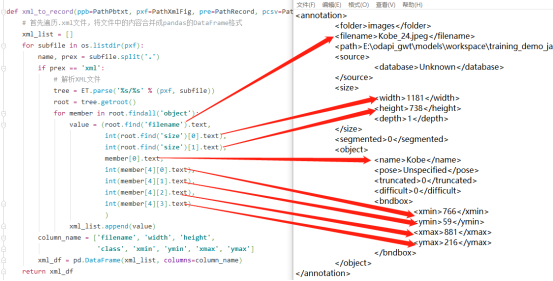
运行完毕后

4.3 构建训练任务
4.3.1 获取预训练模型
使用预训练模型进行训练,将前面下载好的模型文件夹复制到pre-trained-models文件夹内,结构和上图类似。可以将多个模型按照同样方式复制过来。

4.3.2 配置训练管道
在models文件夹下面新建一个自定义文件夹,将要用的预训练模型中的pipeline.config文件复制到该文件夹下面,
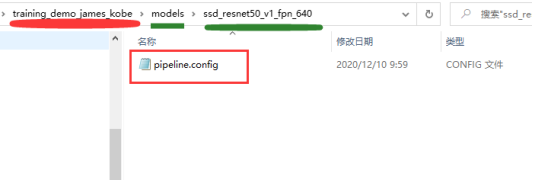
下面对该配置文件进行修改,其中关于路径的设置都设置为E:\odapi_gwt\models\workspace\training_demo_james_kobe的相对路径。
4.3.2.1 设置检测对象类
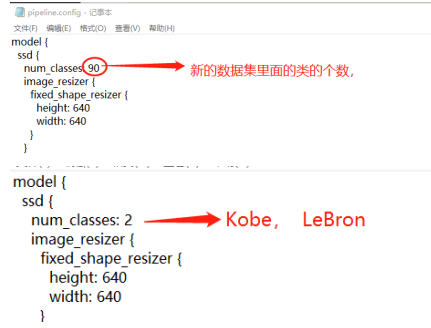
4.3.2.2 设置批训练大小
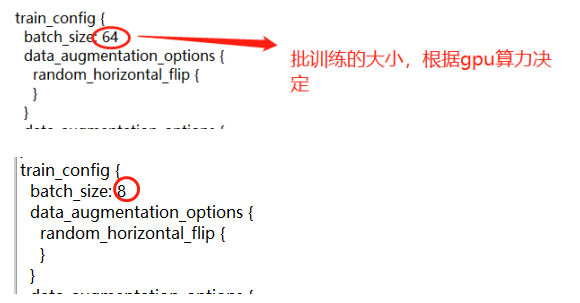
4.3.2.3 模型配置
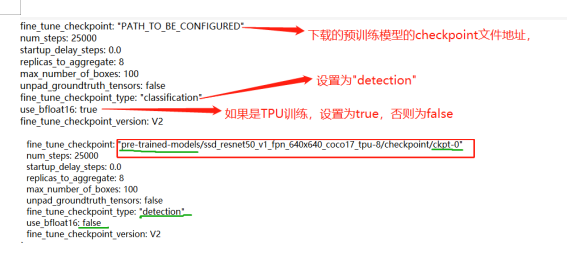
4.3.2.4 训练数据集
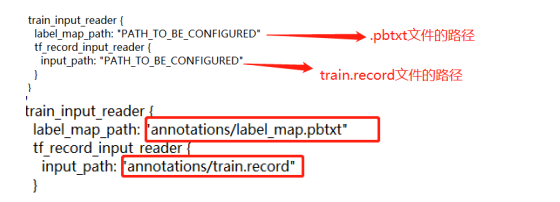
4.3.2.5 测试数据集
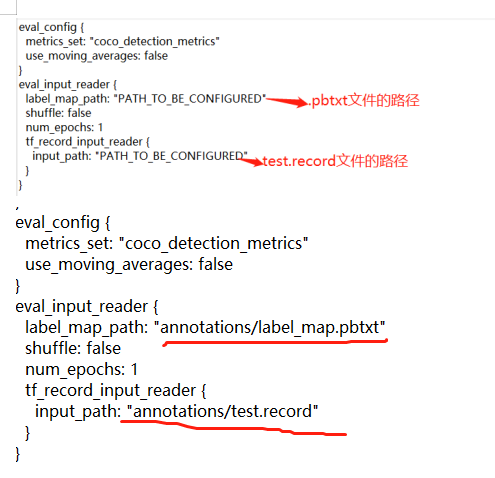
4.3.3 训练模型
将/models/research/object_detection/model_main_tf2.py文件,复制到training_demo_james_kobe文件夹内。

激活虚拟环境,打开training_demo_james_kobe,运行命令
==python model_main_tf2.py --model_dir=models/ssd_resnet50_v1_fpn_640 --pipeline_config_path=models/ssd_resnet50_v1_fpn_640/pipeline.config==

4.3.3.1 No module named 'lvis'

解决办法:激活虚拟环境,运行命令 ==pip install lvis==
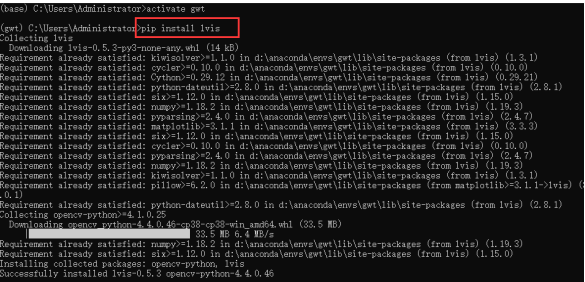
4.3.3.2 No module named 'official'
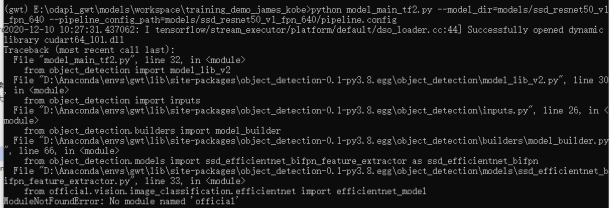
解决办法:将
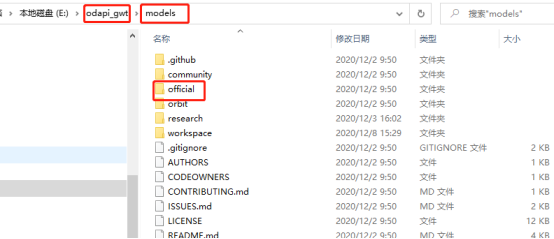
复制到

4.3.3.3 No module named 'yaml'
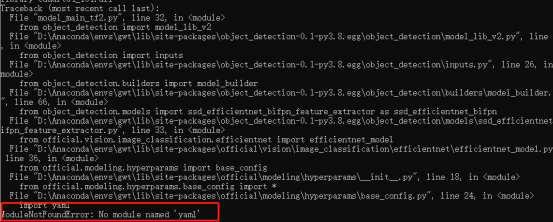
解决办法:激活虚拟环境,运行命令 ==pip install pyyaml==

4.3.3.4 开始训练
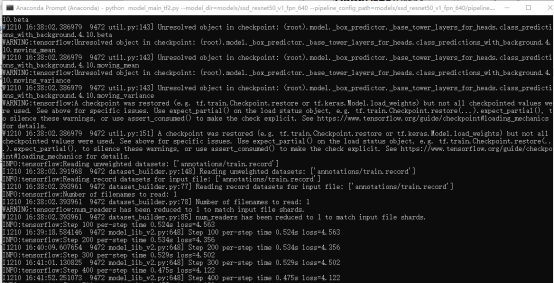
4.3.4 训练过程可视化
在打开Anaconda Prompt,激活虚拟环境,打开路径,执行==tensorboard --logdir=models/ssd_resnet50_v1_fpn_640==


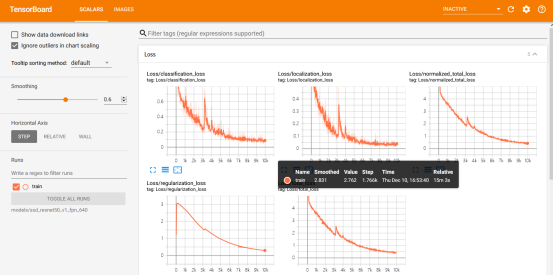
4.4 评估模型
三种评估标准,对应修改pipeline.config文件的178-179 行。
4.4.1 设置评估标准

- PASCAL VOC 2010 detection metric
metrics_set='pascal_voc_detection_metrics'
- COCO detection metrics
metrics_set='coco_detection_metrics'
- Open Images V2 detection metric
metrics_set='oid_V2_detection_metrics'
4.4.2 评估
在打开Anaconda Prompt,激活虚拟环境,打开路径,执行
==python model_main_tf2.py --model_dir=models/ssd_resnet50_v1_fpn_640 --pipeline_config_path=models/ssd_resnet50_v1_fpn_640/pipeline.config --checkpoint_dir=models/ssd_resnet50_v1_fpn_640==

评估的是最新保存的模型

如果出现 'numpy.float64' object cannot be interpreted as an integer错误,
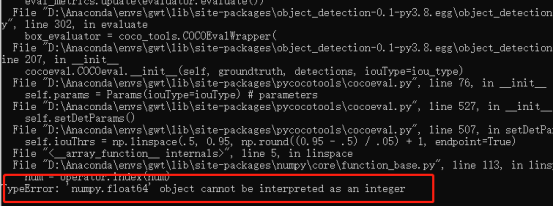
解决办法:找到报错的文件,需要修改507、508行
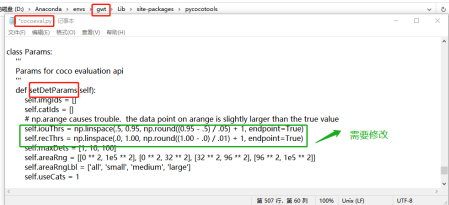
修改后:
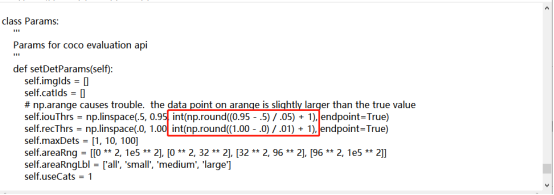
保存,再次运行即可。
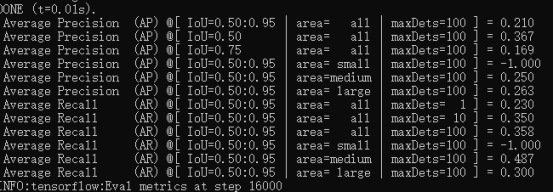
4.4.3 评估结果查看
评估结果保存在


4.5 模型保存
模型训练完毕后,将models/research/object_detection/exporter_main_v2.py文件复制到下面文件夹中。
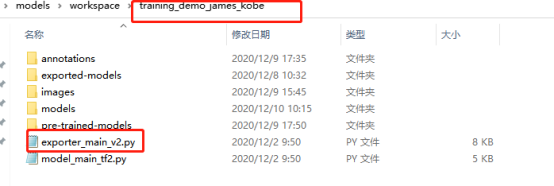
激活虚拟环境,cd打开路径E:\odapi_gwt\models\workspace\training_demo_james_kobe,执行下面的命令
==python exporter_main_v2.py --input_type image_tensor --pipeline_config_path models\ssd_resnet50_v1_fpn_640\pipeline.config --trained_checkpoint_dir models\ssd_resnet50_v1_fpn_640\ --output_directory exported-models\Lebron_Kobe_Model==
出现错误

解决办法,修改蓝框中的文件的第140行,

修改后,

保存,再运行命令即可。

运行完成后的结果

4.6 模型预测
利用保存的模型进行预测,python程序
#!/usr/bin/env python
# author:AnFany
# datetime:2020/12/11 13:55
# 利用刚保存的模型进行图片的预测
import os
import tensorflow as tf
from object_detection.utils import label_map_util
from object_detection.utils import visualization_utils as viz_utils
import numpy as np
from PIL import Image
# 模型名称
Model_Path = r'E:\odapi_gwt\models\workspace\training_demo_james_kobe\exported-models\Lebron_Kobe_Model'
# 输入图片路径
In_Figure_Path = r'E:\TF_OD\IN_Figure'
# 输出图片路径
Out_Figure_Path = r'E:\TF_OD\Out_Figure'
# 标签文件
PATH_TO_LABELS = r'E:\odapi_gwt\models\workspace\training_demo_james_kobe\annotations\label_map.pbtxt'
# 图片格式转为数组
def load_image_into_numpy_array(path):
return np.array(Image.open(path))
def figure_object_detection(modelp=Model_Path, infigurep=In_Figure_Path, labelsp=PATH_TO_LABELS, outfigure=Out_Figure_Path):
"""
实现图片的目标检测
:param modelp: 模型路径
:param infigurep: 输入图片的路径
:param labelsp: 标签路径
:param oj: 需要识别出的类别
:return: 识别出的图片存放路径
"""
# 获取识别物体的标签对应字典
category_index = label_map_util.create_category_index_from_labelmap(labelsp, use_display_name=True)
# 加载模型
detect_fn = tf.saved_model.load(modelp + "/saved_model")
# 图片转数组
for f in os.listdir(infigurep):
image_np = load_image_into_numpy_array(r'%s/%s' %(infigurep, f))
input_tensor = tf.convert_to_tensor(image_np)
input_tensor = input_tensor[tf.newaxis, ...]
detections = detect_fn(input_tensor)
num_detections = int(detections.pop('num_detections'))
detections = {key: value[0, :num_detections].numpy() for key, value in detections.items()}
detections['num_detections'] = num_detections
detections['detection_classes'] = detections['detection_classes'].astype(np.int64)
image_np_with_detections = image_np.copy()
viz_utils.visualize_boxes_and_labels_on_image_array(
image_np_with_detections,
detections['detection_boxes'],
detections['detection_classes'],
detections['detection_scores'],
category_index,
use_normalized_coordinates=True,
max_boxes_to_draw=200,
min_score_thresh=.30,
agnostic_mode=False)
# 保存为图片
image = Image.fromarray(image_np_with_detections, 'RGB')
image.save(r'%s/%s' % (outfigure, f))
figure_object_detection()